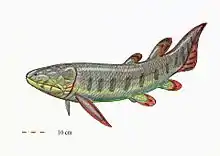South American lungfish
The South American lungfish (Lepidosiren paradoxa) is the single species of lungfish found in swamps and slow-moving waters of the Amazon, Paraguay, and lower Paraná River basins in South America.[5] Notable as an obligate air-breather, it is the sole member of its family Lepidosirenidae. Relatively little is known about the South American lungfish. Additional common names include American mud-fish[6] and scaly salamanderfish.[7] In Brazil, it is known by the indigenous language Tupi name piramboia, which means "snake-fish" (Portuguese pronunciation: [piɾɐ̃ˈbɔj.jɐ]), and synonyms pirarucu-bóia ([piɾɐɾuˈku ˈbɔj.jɐ]), traíra-bóia ([tɾɐˈiɾɐ ˈbɔj.jɐ]), and caramuru ([kɐɾɐmuˈɾu]).
| South American lungfish | |
|---|---|
 | |
| Scientific classification | |
| Kingdom: | Animalia |
| Phylum: | Chordata |
| Order: | Dipnoi |
| Suborder: | Ceratodontoidei |
| Family: | Lepidosirenidae |
| Genus: | Lepidosiren Fitzinger, 1837 |
| Species: | L. paradoxa |
| Binomial name | |
| Lepidosiren paradoxa Fitzinger, 1837 | |
| Synonyms[2][3][4] | |
| |
The immature lungfish is spotted with gold on a black background; in the adult, this fades to a brown or gray color.[8] Its tooth-bearing premaxillary and maxillary bones are fused as in all Dipnoi. South American lungfish also share an autostylic jaw suspension (where the palatoquadrate is fused to the cranium) and powerful adductor jaw muscles with the extant Dipnoi. Like the African lungfishes, this species has an elongated, almost eel-like body. It may reach a length of 125 cm (4.10 ft).[5] The pectoral fins are thin and thread-like, while the pelvic fins are somewhat larger, and set far back. The fins are connected to the shoulder by a single bone, which is a marked difference from most fish, whose fins usually have at least four bones at their base, and a marked similarity with nearly all land-dwelling vertebrates.[9] The gills are greatly reduced and essentially non-functional in the adults.[10]


Juvenile lungfish feed on insect larvae and snails, while adults are omnivorous, adding algae and shrimp to their diets, crushing them with their heavily mineralized tooth-plates. The fish's usual habitats disappear during the dry season, so they burrow into the mud and make a chamber about 30–50 cm (12–20 in) down, leaving a few holes to the surface for air.[10] During this aestivation, they produce a layer of mucus to seal in moisture, and slow their metabolism down greatly.[8]
When the rainy season begins, they come out and begin mating. The parents build a nest for the young, which resemble tadpoles and have four external gills. To enrich the oxygen in the nest, the male develops highly vascularized structures on his pelvic fins that release additional oxygen into the water.[10] The young become air-breathing at about seven weeks. Juveniles have external threadlike gills very much like those of newts.[8] Fossils of the modern species have been found between 72 and 66 mya during the Maastrichtian stage of the late Cretaceous just before the KPG extinction that killed off the Non avian dinosaurs. [11]
References
- "Lepidosiren paradoxa Fitzinger 1837 (South American lungfish)". PBDB.
- "Part 7- Vertebrates". Collection of genus-group names in a systematic arrangement. Retrieved 30 June 2016.
- Haaramo, Mikko (2007). "Ceratodiformes – recent lungfishes". Mikko's Phylogeny Archive. Retrieved 3 July 2016.
- Froese, R.; Pauly, D. (2017). "Lepidosirenidae". FishBase version (02/2017). Retrieved 18 May 2017.
- Froese, Rainer and Pauly, Daniel, eds. (2014). "Lepidosiren paradoxa" in FishBase. April 2014 version.
- Ernst Heinrich Philipp August Haeckel; Edwin Ray Lankester; L. Dora Schmitz (1892). The History of Creation, Or, The Development of the Earth and Its Inhabitants by the Action of Natural Causes: A Popular Exposition of the Doctrine of Evolution in General, and of that of Darwin, Goethe, and Lamarck in Particular : from the 8. German Ed. of Ernst Haeckel. D. Appleton. p. 422. page 289
- Konrad Guenther; Bernard Miall (1931). A Naturalist in Brazil: The Record of a Year's Observation of Her Flora, Her Fauna, and Her People. Houghton Mifflin Company. pp. 399. page 275
- Animal-world: South American Lungfish.
- "Your Inner Fish" Neil Shubin, 2008,2009,Vintage, p.33
- Bruton, Michael N. (1998). Paxton, J.R.; Eschmeyer, W.N. (eds.). Encyclopedia of Fishes. San Diego: Academic Press. p. 70. ISBN 0-12-547665-5.
- "Lepidosiren Fitzinger 1837 (South American lungfish)". PBDB.
External links
| Wikispecies has information related to Lepidosiren paradoxa. |
| Wikimedia Commons has media related to Lepidosiren paradoxa. |

.jpg.webp)


